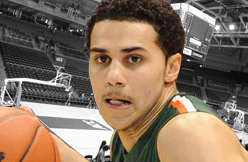BOSTON – Shane Larkin is still learning how to play in the NBA, but if there’s one thing he can already do at an elite level, it’s get steals.
Tony Allen, John Wall, Mario Chalmers and Elfrid Payton are the only guards who’ve played as much as Larkin this season and stolen the ball on a higher percentage of opponents’ possessions when on the court.
I ask Larkin the key to getting so getting so many steals.
“Fast and short,” interjects Knicks rookie Cleanthony Early, one locker over.
After playfully chiding Early for interrupting the interview, Larkin insists the simple assessment is inaccurate.
“It’s more than that, because there’s a lot of short, fast guys who don’t get steals,” said Larkin, 22, the Knicks’ youngest player. “It’s anticipation, seeing things happening before they happen.”
Larkin sure does that.
In the last six months, Larkin has been traded and had the third-year team option on his rookie contract declined, sending his career into a bit of chaos.
Overwhelming? Nah. Larkin saw it all coming.
The Mavericks acquired Larkin, the No. 18 pick in 2013, in a draft-night trade. An injury-riddled rookie year put him on the outside looking in at Dallas’ rotation this season. He understood the Mavericks were trying to win now around Dirk Nowitzki – “Dirk deserves that,” Larkin said – and predicted a trade. Dallas dealt him to the Knicks in June.
In New York, he realized the Knicks were trying to maximize 2015 cap space. So, he also understood why they called him into an office just before the season to tell him they were declining his option for the 2015-16 season.
Now, Larkin will become an unrestricted free agent this summer – a rare predicament/opportunity for a player with his résumé and a crucial moment for the Knicks, who’ve long struggled to develop and keep young talent.
Larkin’s production – 5.4 points, 2.3 assists, 1.8 rebounds and 1.2 steals in 23.0 minutes per game – is modest, but he’s beginning to make good on the potential he showed before the draft. The 5-foot-11 point guard jumped 44 inches at the combine, the fifth-best mark in the DraftExpress database. He also had the fastest sprint time among players drafted in his class.
No doubt, Larkin, who turned pro following his sophomore season at Miami and is the son of baseball Hall of Famer Barry Larkin, has talent. His upside makes New York’s decision to decline his option all the more suspect.
The Knicks’ motivations are clear. They want to pursue big-time free agents next summer, pitching Carmelo Anthony’s star power, Phil Jackson’s winning pedigree and New York’s market share. By declining Larkin’s option and presumably renouncing him, they’ll gain $1,150,227 in cap room. If they renounce all their free agents, they could create more than $22 million in cap space.
Depending where the salary cap actually lands, declining Larkin’s option could make the difference between New York being able to offer someone a max contract. If that proves to be the case and the Knicks land a big free agent, the move will be a huge success.
But it’s risky to cast aside a promising young player on a cheap contract just for the chance of signing a star, especially when dropping the young player isn’t even guaranteed to increase the odds of nabbing the star. What if the Knicks would have had enough cap room to sign their top target with Larking remaining on the roster?
It’s not as if the Knicks can afford to keep throwing away young talent. That’s what got them into their current mess.
Make no mistake: Larkin is hardly an elite prospect. But he’s a former top-20 pick under the age of 24, a combination that shows his potential. Sure, there are 68 such players in the league, making the distinction far from unique. But Larkin is the Knicks’ only one.

(probasketballtalk.com)



